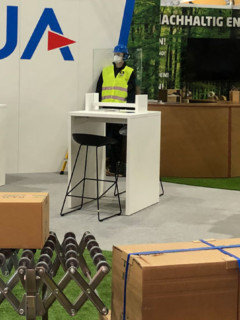Internal traffic routes are all areas in the company that serve the internal movement of people and goods. This includes corridors, hallways, streets, ramps, stairs, ramps, galleries, but also car parks and the routes in production halls and warehouses. Good planning of internal traffic routes helps to avoid accidents, but also to increase efficiency.
A lot of things are moved in our company. Consignments for the whole of Europe leave our central warehouse in Tongeren, Belgium, every day. To make it all work, often hundreds, thousands of kilograms of goods are lifted, transported, picked, stored, moved, weighed, driven, sorted, checked, packed and loaded. Countless pallet trucks, forklifts and “ants” move seemingly effortlessly in a “ballet” that is inscrutable from the outside. It’s good if everyone knows exactly where to move – and where not to move! This only works with good internal traffic route planning.
Internal transport routes – what are they?
Internal traffic routes are all areas in a company that are used for the internal movement of people and goods. This includes corridors, hallways, roads, ramps, stairs, ramps, galleries, but also car parks and the routes in production halls and warehouses.These areas or “paths” must be clearly marked and separated from each other. No forklift truck has any business in an area marked for pedestrians. Conversely, pedestrians in the loading zone must exercise “no trespassing” or the utmost care: here I must expect a transport truck to cross my path at any time.
Why is it necessary to plan internal transport routes?
Careful planning and design of internal traffic routes is immensely important for two reasons: On the one hand, it is about safety at work and the prevention of accidents. On the other hand, optimal traffic route planning also stands for smooth and fast logistics – and thus for not “wasting” unnecessary time.Who is responsible for traffic route safety in the company?
Basically, the land owner. If the site is used commercially, in most cases the site owner is identical with the employer, who in turn transfers safety-relevant duties to his occupational safety specialist. This includes duties as we know them from the private sector: Clearing and gritting services in winter, the removal of potential tripping hazards such as sunken pavement slabs. But beyond that, it also includes the implementation of all requirements of the Occupational Health and Safety Act (see also VNR Verlag für die Deutsche Wirtschaft).Sources of danger in the workplace
The following points are usually cited as causes of accidents in the workplace that fall into the area of traffic route safety:Inadequate separation of driving area and pedestrian area.
Soiling, unevenness
Insufficient lighting, poorly visible areas
Inadequate instruction of employees
When do most accidents happen?
According to the DGVU, 30% of all reportable accidents occur out of motion (walking, running, ect.), specifically: 1,000 accidents per day! This means that even well ahead of the handling of hand tools (19.9%) or machinery (5.2%), the cause of by far the most frequent accidents was: tripping, slipping, falling or collisions of any kind. The costs of these so-called SRS accidents (tripping, slipping, falling) amount to 330 million euros per year.What regulations are there to comply with?
The Technical Rules for Workplaces (ASR). They regulate the installation of circulation routes (A1.8) and their marking (A1.3).By the way:
The Technical Rules for Workplaces are determined or adapted by the Committee for Workplaces and published by the Federal Ministry of Labour and Social Affairs in the Joint Ministerial Gazette.
In addition to very general regulations such as
- Traffic routes must be clearly laid out and should run as straight as possible.
- traffic routes must always be laid out horizontally
there are also very specific specifications for, for example
- the maximum angle of inclination of a ramp or
- the minimum width of paths for pedestrian traffic (according to the number of “moving” persons.
Read more in the ASR: What specific regulations apply to stairs and ladders? For ramps, pedestrian walkways and their demarcation?
Mandatory labelling
The Technical Rules for Workplaces also regulate the marking of traffic routes. It states: 1 If hazards in the course of traffic routes cannot be prevented or eliminated by technical measures, or if hazards arise from vehicle traffic due to unclear operating conditions (e.g. due to working and storage areas without fixed fixtures), the traffic routes must be clearly recognisable in accordance with ASR A1.3 “Safety and Health Signage”, e.g. a permanent hazard in the form of a compensation step in the traffic route by means of yellow and black stripes or a temporary hazard based on spilled liquid by means of the warning sign W011 “Warning of danger of slipping”. Marking can be omitted if the traffic routes are clearly defined by fixed operating equipment (e.g. shelves) and no hazards arise as a result. 2 Various forms of marking (e.g. permanent colour marking, marker lights) can be used to indicate the demarcation between traffic routes at the same level and surrounding work and storage areas, as well as between routes for pedestrian and vehicle traffic. 3 If the result of the risk assessment makes it necessary, railings or guard rails are to be placed to delimit between traffic routes at the same level and surrounding work and storage areas as well as between routes for pedestrian and vehicle traffic.Where can I find support on the subject of accident prevention and occupational safety?
In the company, the occupational safety officer is responsible for ensuring compliance with the regulations. This can be an employee who has acquired a certificate through training in the individual areas (training courses are offered by the Chamber of Industry and Commerce, for example). Due to the complexity of the topic, however, many companies decide to appoint an external ASB (occupational safety and health officer), for example from an engineering firm.Always a good and helpful contact: the employers’ liability insurance associations and the regionally responsible chamber of industry and commerce. They often have checklists or guides on the subject.
Compulsory: The occupational safety committee meets four times a year
The occupational safety committee basically discusses topics such as escape routes, evacuation plans, fire protection, first aiders and even internal traffic route safety: Were there any reportable accidents? Accident black spots? How can remedial action be taken?Participants in the occupational safety committee are: Occupational safety officer, works council representative, managing director, company doctor and representative from the HR department.

















